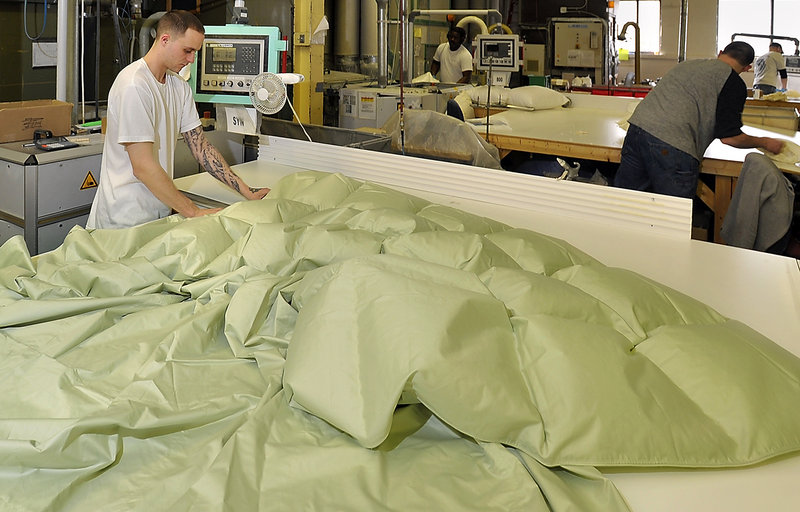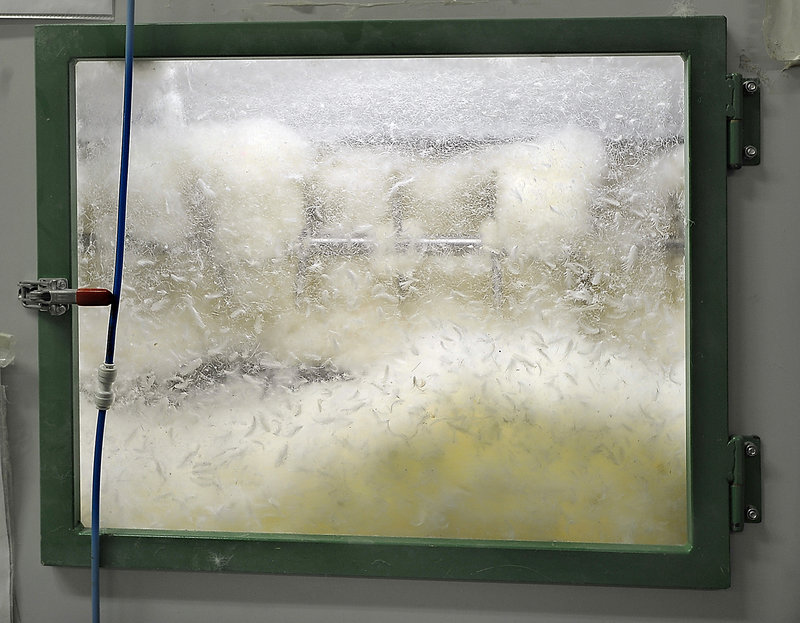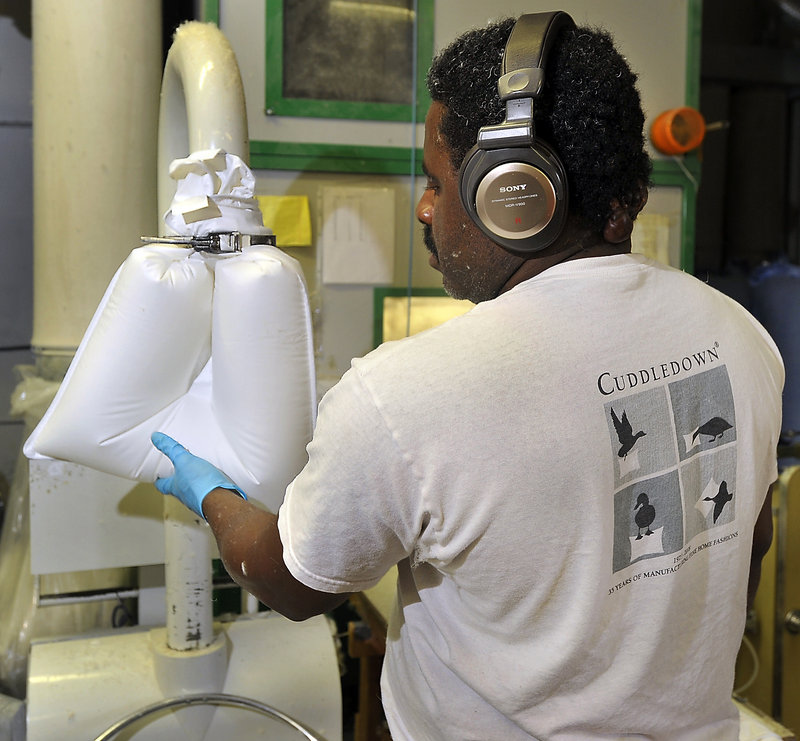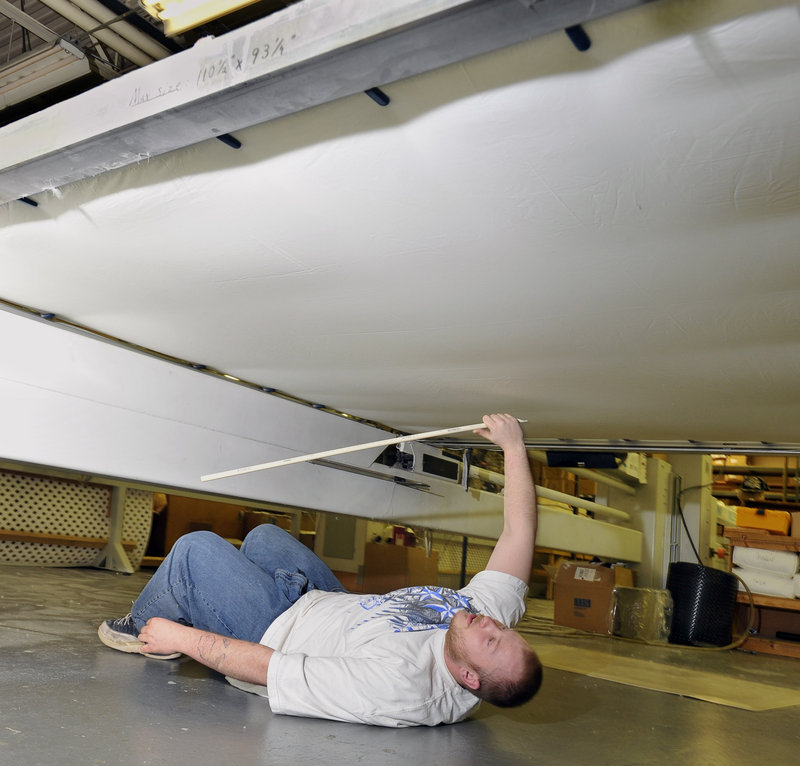PORTLAND – Scott Braman swiped his box knife across a plastic sack inside the Portland headquarters of Cuddledown.
He reached into the gash, retrieving a handful of snow white, European goose down.
“Look. It’s not like feathers,” said Braman, Cuddledown’s production manager, carefully opening his hand. “(Down has) a three-dimensional structure, like a dandelion. Feathers have a curve.”
For Braman and Cuddledown, that’s a critical distinction.
The remarkable growth and continued expansion of the nearly 40-year-old Maine company, which makes high-end comforters and pillows, is due largely to the caliber of the goose and duck down stuffed inside the company’s products.
“We are not trying to cut corners,” said Chris Bradley, Cuddledown’s president and CEO, adding that his company — and his customers — focus more on quality than price.
Cuddledown was founded in 1973 by Ellen Manson, who sold the company in the mid-1980s to Gerry Parker.
In 1988, Cuddledown changed hands once more, purchased this time by Bradley, a former Wall Street executive who had recently moved to Maine.
Bradley said Cuddledown had flourished under Manson’s leadership, but under Parker’s lead lacked strong branding and only printed one catalog yearly.
Bradley declined to discuss the purchase price but said he inherited a troubled, 10-employee company operating in the red.
“My first step was to lose a lot of money,” he said.
Though he knew little about fabrics and textiles, Bradley came to Cuddledown with years of business experience and an MBA from the University of Utah.
He immediately began producing and shipping more catalogs, and personally wrote all the product descriptions. He also expanded Cuddledown’s product line,
Today, Cuddledown makes a variety of bed and bathroom goods, including pillows, sheets, duvet covers, feather beds, pet beds, pajamas and bath towels.
But at its core, Cuddledown is a pillow and comforter company, and its prime raw material is the ultra-soft down of ducks and geese.
Braman said the company’s down and feathers typically come from geese and ducks in Eastern European countries like Hungary, Poland and the Czech Republic.
But some of Cuddledown’s priciest products are stuffed with eiderdown, which is harvested from eider duck nests by Icelandic farmers.
Unlike a bird’s longer outer feathers, Braman said, down feathers are smaller, lighter and softer. They are found near the skin, typically on a bird’s breast, and don’t have long quills.
The fluffiness — and the warmth — of down is measured in so-called “fill power” — an industry phrase for the number of cubic inches occupied by one ounce. The higher the number, the better.
Cuddledown’s comforters have fill-rates between 600 and 900. Prices start at roughly $140 for twin-size comforters, but climb as high as $13,559 for king-size, eiderdown comforters.
Braman said Cuddledown’s storage room houses roughly $300,000 worth of down, enough for about a month’s worth of production.
When the down is needed, workers dump the bags into troughs connected to air ducts. Fans suck the down from the storage room to the production room, where it is dumped into Dutch-made silos.
Inside the silos, which are roughly 10 feet high and have clear windows, the down is stirred, agitated and aerated like cotton candy.
Then it’s blown into so-called goose necks — German machines with curved pipes that fill empty pillow and comforter shells with down.
Next, a worker sews the shells closed and adds a required government tag.
The comforters then need one last step. They are stretched across a “lift table,” which rolls under a quilting machine for further stitching.
Braman said Cuddledown, which has roughly 100 employees, makes some 16,000 comforters and 65,000 pillows at the plant yearly.
Bradley said revenue increased 11 percent in 2010 after a 5 percent drop during 2009, when the company felt the impact of the recession. Bradley said so far in 2011, business is up 28 percent.
He added that sales have grown 30 times since he bought the company.
Bradley said most sales are made direct to consumers through Cuddledown’s website and catalogs, which are printed by Lisbon’s Dingley Press on paper made by Verso Paper Corp. in Maine.
Every year, Cuddledown mails 15 million catalogs and processes some 100,000 orders, Bradley said. Eleven percent of the company’s sales are to customers in California, a large state that Bradley said has many high-income residents.
Cuddledown owns one retail store, which is located in Freeport.
Customers can also buy Cuddledown products at a handful of retailers across the country, including The Linen Kist at Vail/Beaver Creek in Colorado.
Linen Kist owner Nancy Rehder said Cuddledown is one of a handful of companies that make high-end down comforters. Others include Scandia Down, Pacific Coast Feather Company, Cloud Nine Comforts and DownTown Company.
Because Rehder has limited retail space, every few years she sits down and studies each company’s products. She looks at price, quality and weight, searching for the best product at the best price.
Rehder said Cuddledown is among the best. She likes the ultra-soft down and the high thread count in the shell.
She said there’s a big difference between premium down comforters, like those made by Cuddledown, and comforters sold at big-box retailers.
For starters, she said, low-end comforters are often stuffed with feathers, not down, or even shredded plastic. (Cuddledown sells some less expensive comforters made with feather-down mixtures, and some with synthetic down.)
Also, she said, lower-cost products tend to be heavier and bulkier.
“The lighter and the fuller, the better. If it’s heavy and fat, it’s crummy down,” Rehder said.
She has only one complaint: Cuddledown sells its products direct to consumers at prices her retail store can’t match.
“I pay staff and rent and shipping, and I stock (the products),” she said. “When Cuddledown sells it in a catalog or online for less than I can sell it for … I can look like a fool.”
But Rehder said the products still sell well at her store, which caters largely to high-income visitors to Vail, in the heart of Colorado’s ski country.
Bradley said he competes with retail stores like Bed, Bath & Beyond, Pottery Barn and Macy’s, as well as catalog companies like The Company Store and Restoration Hardware.
Cuddledown products can be found in the rooms of a number of smaller, upscale inns and hotels across the country. Bradley said one goal this year is to expand hotel sales by producing products that might appeal to larger hotel chains.
“Hotels don’t want to buy 100 percent cotton sheets,” he said. “They want cotton-polyester.”
One hotel that already stocks Cuddledown pillows and comforters is the 18-cottage Winvian Inn in Morris, Conn.
Heather Smith-Winkelmann, the inn’s managing director, said her staff tested samples from a number of companies back in 2006 and ended up going with Cuddledown.
“(The decision) was based on quality. And we had to have something that was durable,” she said, adding that the products have “held up beautifully.”
Although Cuddledown’s products are pricier than other brands, Smith-Winkelmann said the products fit the inn’s high-end image.
“In order to charge top dollar, we have to provide the amenities. Cuddledown happens to be expensive, but it has been worth it,” she said.
Jonathan Hemmerdinger can be reached at 791-6316 or: jhemmerdinger@mainetoday.com
Send questions/comments to the editors.





